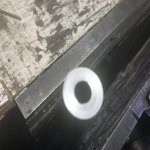Well, hello CGNers!
I bought a garden variety Enfield sporter.
When i examine the barrel i see very little in the way of rifling - lands & grooves. I see the spiral pattern but not any depth.
Yet, when I do the bullet test (stick a bullet into the muzzle to see how tight the fit is), it only goes halfway in. The bullet test indicates a less-worn barrel.
And so: my Enfield Newbie Question is: is the rifling in Enfield barrels shallow? And as such does the above sound normal?
Grateful for your knowledge here.
I bought a garden variety Enfield sporter.
When i examine the barrel i see very little in the way of rifling - lands & grooves. I see the spiral pattern but not any depth.
Yet, when I do the bullet test (stick a bullet into the muzzle to see how tight the fit is), it only goes halfway in. The bullet test indicates a less-worn barrel.
And so: my Enfield Newbie Question is: is the rifling in Enfield barrels shallow? And as such does the above sound normal?
Grateful for your knowledge here.












































































